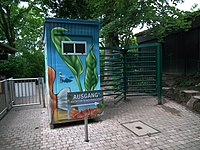Tag:entrance=exit
Jump to navigation
Jump to search
 |
| Description |
|---|
| It is not an entrance, it is a one-way out of a building. You can find these at public transport locations, some larger shops, museums and theme parks. |
| Group: man made |
| Used on these elements |
| Status: approved |
| Tools for this tag |
It is not an entrance, it is a one-way out of a building. You can find these at public transport locations (airports, subway stations) some larger shops, museums and theme parks.
How to map
Add a node ![]() at the building or area outline and tag it with
at the building or area outline and tag it with entrance=exit, a popular alternative is to use one of the normal entrance tag values with exit=yes.
Alternatives
See the forum discussion, a popular alternative is to use one of the normal entrance tag values with exit=yes.
Other options are to add oneway:foot=yes to the highway=footway leading to the entrance or use direction=* with a normal entrance tag value.